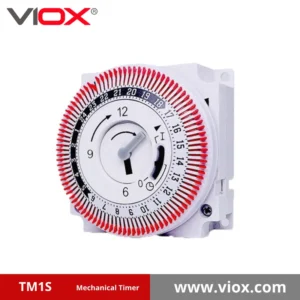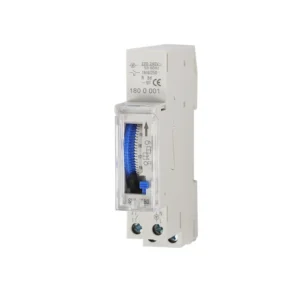VIOX MECHANICAL TIMER SWITCH COLLECTION

As a leading supplier of mechanical timer switches, VIOX is committed to producing only high-quality products. We continually explore new functionalities and features, guided by current usage patterns and customer feedback. This approach ensures VIOX timer switches meet evolving market needs while maintaining our reputation for excellence.
| Digital Timer Switch | AHC15A | AHC15D | AHC20A | AHC17A | AHD16T | AHC610 | AHC612 | AHC613 | AHC614 | AHC615 | AHC616 | AHC617 | AHC810 | AHC812 | AHC811 | AHC822 | AHC808 | AHW11-1 |
|---|---|---|---|---|---|---|---|---|---|---|---|---|---|---|---|---|---|---|
| Number of Memory Locations | 20 | 20 | 20 | 20 | 8 | 30 | 30+30 | 16 | 16+16 | 4*15 | 4*C1/15+C2/15 | 4*28 | 58 | 58 | 58 | 58 | 16 | 30 |
| Daily/Weekly/Pulse Programs | Yes | Yes | Yes | Yes | Yes | Yes | Yes | Yes | Yes | Yes | Yes | Yes | Yes | Yes | Yes | Yes | Yes | Yes |
| Number of Channels | 1 | 1 | 1 | 1 | 1 | 2 | 1 | 2 | 1 | 2 | 1 | 2 | 1 | 1 | 1 | 1 | 1 | 1 |
| Operating Voltage | 230V AC | 110V–230V AC | 230V AC | 230V AC | 230V AC | 230VAC/110V–230VAC/12VDC/24VDC/12V–48VDC | 230VAC/110V–230VAC/12VDC/24VDC/12V–48VDC | 230VAC/110V–230VAC/12VDC/24VDC/12V–48VDC | 230VAC/110V–230VAC/12VDC/24VDC/12V–48VDC | 230VAC/110V–230VAC/12VDC/24VDC/12V–48VDC | 230VAC/110V–230VAC/12VDC/24VDC/12V–48VDC | 230VAC/110V–230VAC/12VDC/24VDC/12V–48VDC | 230VAC/110V–230VAC/12VDC/24VDC/12V–48VDC | 230V AC | 85–265V AC | |||
| Rated Current | 16 Amp | 16 Amp | 16 Amp | 16 Amp | 16 Amp | 16 Amp | 16 Amp | 16 Amp | 16 Amp | 16 Amp | 16 Amp | 16 Amp | 16 Amp | 16 Amp | 16 Amp | 16 Amp | 16 Amp | 16 Amp |
| Width | 2 modules | 2 modules | 2 modules | 2 modules | 2 modules | 2 modules | 2 modules | 2 modules | 2 modules | 2 modules | 2 modules | 2 modules | 1 module | 2 modules | ||||
| Power Reserve | 3 Years | 3 Years | 3 Years | 3 Years | 3 Years | 5 Years | 5 Years | 5 Years | 5 Years | 5 Years | 5 Years | 5 Years | 3 Years | – | ||||
| Power Consumption | 3 VA | 3 VA | 5 VA | 5 VA | 3 VA | 4 VA | 4 VA | 7 VA | 7 VA | 7 VA | 7 VA | 7 VA | 1.5–6.5 VA | 4 VA | 2 W |
Advantages of VIOX mechanical TIMER SWITCH
User-Friendly Reliability
Because mechanical timer switches have fewer electronic components, they are less likely to malfunction due to power surges or interference, meaning that they can be used by users of all skill levels. They are also more durable and simple to use than other timer switches. Furthermore, because of their sturdy construction, mechanical timers require less maintenance over time because they are easy to use and don't require complicated programming.
Cost-Effective Energy Management
These timers offer a cost-effective way to automate device functions, which results in substantial energy savings. Their reduced starting cost and capacity to cut back on wasteful energy use translate into lower electricity costs and a smaller carbon footprint. Because they combine affordability and efficiency, mechanical timers become a desirable alternative for energy management measures in both home and business settings.
Versatile Security and Adaptability
Because they can be used for a wide range of tasks, from household chores to industrial processes, mechanical timer switches are incredibly versatile. They can even be used in critical situations by maintaining preset schedules during power outages. Additionally, because they can automate lighting schedules, mechanical timers can simulate occupancy, which improves security in homes and businesses. This versatility, along with their power independence, makes mechanical timers valuable tools across different sectors.
Full guide of Mechanical TIMER SWITCH
What is Mechanical timer switch ?
Mechanical timer switches are analog devices that regulate the on and off periods of electrical appliances. They are extensively employed in many different applications, such as heating, lighting, and other electrical equipment. This article will go over their functions, types that are available, setup instructions, and performance-enhancing advice.
How Mechanical Timer Switches Work?
Electric motors, gears, and springs are some of the actual parts that mechanical timer switches use to function. Together, these parts control the power supply according to user-specified time intervals:
- Timepieces Mechanism: The timer tracks time by use of mechanical motions.
- Manual Configuration: By modifying the device’s dials or pins, users can select the preferred ON and OFF times.
Because of their affordability and ease of use, mechanical timers continue to be favored even in the face of digital substitutes.
Types of Mechanical Timer Switches
- Analog Timer Switches:These are the traditional mechanical timers that use physical components for operation.
- Plug-In Timer Switches: Designed to be plugged into a wall outlet, these timers control devices plugged into them.
- Segment Timers:These feature segments that can be pushed in or out to set specific ON and OFF times.
Applications
Residential Applications:
- Lighting Control: Automates indoor/outdoor lighting
- HVAC Management: Optimizes heating and cooling systems
- Appliance Timing: Controls small appliances on schedules
Commercial Uses:
- Storefront Lighting: Regulates display illumination
- HVAC Optimization: Manages systems based on occupancy
- Signage Control: Programs illuminated signs for peak hours
Industrial Applications:
- Production Automation: Controls machinery operation times
- Ventilation Systems: Automates air quality management
- Water Treatment: Manages pumps and chemical dosing
Agricultural Uses:
- Irrigation Systems: Automates watering schedules
- Greenhouse Lighting: Controls grow lights for plant cycles
Energy Management:
- Peak Load Reduction: Schedules high-consumption devices
- Renewable Energy Integration: Optimizes use of generated power

Request a Quote
Ready to Work Together? Build a project with us!













